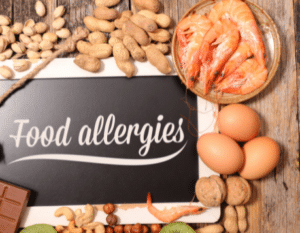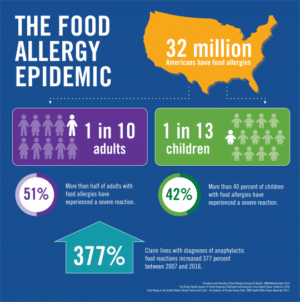
Personally, I am fortunate (perhaps thanks to those farm roots) that neither I nor any of my immediate family have allergies to food. But as a registered dietitian, I am connected to the reality of those who do. Over the past 15 years, I have had the opportunity to work with a local allergist, counseling his food allergic clients on food preparation and eating out strategies and assisting with oral food challenges. There is no cure for food allergies overall, only management strategies. And we all should be aware of these strategies because someone in our circle of friends, colleagues or families already has food allergies or will be diagnosed with an allergy in the future.
Here are five facts to know:
1. Food allergies are serious. When someone experiences any type of reaction (even mild) to a food when eaten, it’s worth the time and money to consult with an allergist. Self-diagnosis is not the route to management as reactions can be associated with other medical conditions rather than food. Even though the skin prick or blood tests are not 100% accurate, they are the best available tests today for diagnosis, along with oral food challenges. Organizations like Food Allergy Research & Education (FARE) are working with the medical community to develop improved diagnostic tools.
2. Food allergies are not food intolerances. When an individual has a food allergy, their immune system produces an antibody called immunoglobulin E (IgE) when it detects a food allergen. The IgE antibodies fight the “enemy” food by releasing histamine and other chemicals, causing symptoms of an allergic reaction. By contrast, food intolerances or oral sensitivities can cause GI distress or swelling of lips but do not involve the immune system and are not life-threatening.
3. A little bit is not OK. The question, “is it OK to eat just a little of “XX” since I don’t have any serious reactions?” has been asked more than once by a client over the years. It’s important to remember that a mild reaction one time doesn’t guarantee how the body will react the next time. Food allergy reactions are unpredictable. For this reason, it’s important not to cross-contact a safe food with an allergen during food preparation or serving. It’s for this reason that home-baked items have been restricted at venues like schools.
4. There now nine identified food allergens. Even though most any food could cause an allergic reaction, the U.S. Food and Drug Administration (FDA) has identified the nine most common foods that typically are diagnosed and requires that they be listed on food packaging. The original eight foods that must be listed in plain-language on labels include milk, egg, soy, peanuts, tree nuts, fish, shellfish and wheat. With the signing of the FASTER Act by President Joe Biden in April, sesame became the ninth allergen that will be required to be declared on labels. Why is this important? There are estimated 1.6 million Americans with a sesame allergy without a safety net. Sesame is often used when a label reads “natural flavors” or “natural spices” without the product label showing its content. With this new law, packaged foods will be required to identify sesame by January 1, 2023.
5. Food allergies know no age limits. Even though allergies to milk, egg, peanuts, soy and wheat are more likely to be diagnosed in infants and children there are no age limits. For shellfish and finned fish (like salmon or cod), the allergy may not be diagnosed until adulthood. About 60% of people with a shellfish allergy and 40% of those with fish allergy experience their first allergic reaction as adults. Allergies to tree nuts can be diagnosed in all ages. The good news is that allergies to food like milk, egg and wheat are typically outgrown. Allergies to shellfish and fish are usually lifelong.
Food allergies are serious and potentially life-threatening medical conditions so take the time this week and month to be aware. Your knowledge may keep someone you know from being one of the individuals “that goes to emergency room every three minutes” due to a food allergy reaction.
Source:
Food Allergy Research & Education (FARE)

